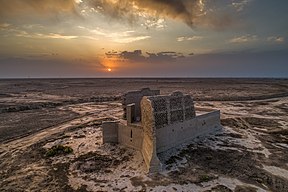
Back سجستان Arabic سیستان AZB Sistan BCL Сістан Byelorussian Sistan Catalan سیستان CKB Sístán Czech Sistan German Sistan DIQ Σιστάν Greek
Sakastan
Sijistan
Sistan
Sijistan
Sistan
Asbad (windmills) in Sistan, Iran[1]
Map of Sistan (labelled Sakastan) in c. 100 BC.
Sistān (Persian: سیستان), also known as Sakastān (Persian: سَكستان "the land of the Saka") and Sijistan (Persian: سِجِستان), is a historical region in present-day south-western Afghanistan, south-eastern Iran and extending across the borders of south-western Pakistan.[2] Mostly corresponding to the then Achaemenid region of Drangiana and extending southwards of the Helmand River not far off from the city of Alexandria in Arachosia (present day Kandahar).[3][4] Largely desert, the region is bisected by the Helmand River, the largest river in Afghanistan, which empties into the Hamun Lake that forms part of the border between Iran and Afghanistan.
- ^ UNESCO. Asbads (windmill) of Iran.
- ^ Classen, Albrecht (2010-11-29). Handbook of Medieval Studies: Terms – Methods – Trends. Walter de Gruyter. p. 6. ISBN 978-3-11-021558-8.
- ^ Ghulam Rahman Amiri (2020-11-01). The Helmand Baluch A Native Ethnography of the People of Southwest Afghanistan. Berghahn Books. p. 7. ISBN 9781800730427.
- ^ N. Rüdiger Schmitt. [1]. Encyclopaedia Iranica. Originally Published: December 15, 1995.

